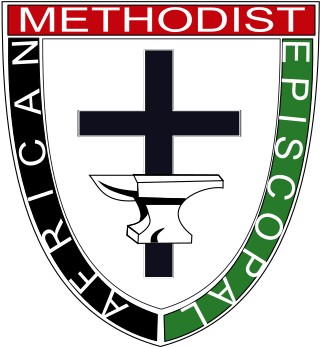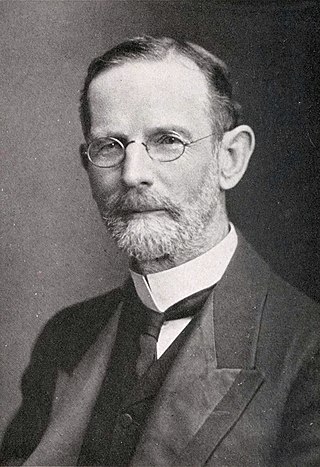Related Research Articles
Methodism, also called the Methodist movement, is a group of historically related denominations of Protestant Christianity whose origins, doctrine and practice derive from the life and teachings of John Wesley. George Whitefield and John's brother Charles Wesley were also significant early leaders in the movement. They were named Methodists for "the methodical way in which they carried out their Christian faith". Methodism originated as a revival movement within Anglicanism originating out of the Church of England in the 18th century and became a separate denomination after Wesley's death. The movement spread throughout the British Empire, the United States, and beyond because of vigorous missionary work, and today has about 80 million adherents worldwide.
The Methodist Episcopal Church (MEC) was the oldest and largest Methodist denomination in the United States from its founding in 1784 until 1939. It was also the first religious denomination in the US to organize itself nationally. In 1939, the MEC reunited with two breakaway Methodist denominations to form the Methodist Church. In 1968, the Methodist Church merged with the Evangelical United Brethren Church to form the United Methodist Church.
The Methodist Episcopal Church, South was the American Methodist denomination resulting from the 19th-century split over the issue of slavery in the Methodist Episcopal Church (MEC). Disagreement on this issue had been increasing in strength for decades between churches of the Northern and Southern United States; in 1845 it resulted in a schism at the General Conference of the MEC held in Louisville, Kentucky.
The Methodist Protestant Church (MPC) is a regional Methodist Christian denomination in the United States. It was formed in 1828 by former members of the Methodist Episcopal Church, remaining Wesleyan in doctrine and worship, but adopting congregational governance.

The African Methodist Episcopal Church, usually called the AME Church or AME, is a Methodist Black church. It adheres to Wesleyan-Arminian theology and has a connexional polity. The African Methodist Episcopal Church is the first independent Protestant denomination to be founded by black people; though it welcomes and has members of all ethnicities.

The African Methodist Episcopal Zion Church, or the AME Zion Church (AMEZ) is a historically African-American Christian denomination based in the United States. It was officially formed in 1821 in New York City, but operated for a number of years before then. The African Methodist Episcopal Zion Church adheres to Wesleyan-Arminian theology.
The Southern Methodist Church is a conservative Protestant Christian denomination with churches located in the southern part of the United States. The church maintains headquarters in Orangeburg, South Carolina.

Walter Russell Lambuth was a Chinese-born American Christian bishop who worked as a missionary establishing schools and hospitals in China, Korea and Japan in the 1880s.
Robert Elijah Jones was an American bishop of the Methodist Episcopal Church and The Methodist Church in the U.S., elected in 1920. Along with Matthew Wesley Clair, Jones was one of the first African-American Bishops of the M.E. Church.
A bishop is a senior role in many Methodist denominations. The bishop's role is typically called the "episcopacy", based on the Greek word episkopos (επισκοπος), which literally means overseer. Superintendent is another translation of episkopos but in Methodist churches this is a role distinct from bishop. The first Methodist bishops were appointed in America, and American Methodist denominations still recognize the office of bishop.
A missionary bishop is one assigned in the Anglican Communion to an area that is not already organized under a bishop of a church. The term was also used in the Methodist churches at one time, but this was discontinued in 1964.
Clement Daniel Rockey was a bishop of the Methodist Church.

William Taylor (1821–1902) was an American Missionary Bishop of the Methodist Episcopal Church, elected in 1884. Taylor University, a Christian college in Indiana, carries his name.

The Anglican Episcopal Church of Brazil is the 19th province of the Anglican Communion, covering the country of Brazil. It is composed of nine dioceses and one missionary district, each headed by a bishop, among whom one is elected as the Primate of Brazil. The current Primate is Marinez Rosa dos Santos Bassotto. IEAB is the oldest non-Catholic church in Brazil, originating from the Treaty of Commerce and Navigation signed in 1810 between Portugal and the United Kingdom which allowed the Church of England to establish chapels in the former Portuguese colony. In 1890 American missionaries from the Episcopal Church established themselves in the country aiming to create a national church; unlike the English chapels, they celebrated services in Portuguese and converted Brazilians. The Anglican community of Brazil was a missionary district of the Episcopal Church until 1965, when it gained its ecclesiastical independence and became a separate province of the Anglican Communion. Twenty years later, IEAB began to ordain women. It preaches a social gospel, being known for its commitment to fight against problems that affect vast portions of the Brazilian society, such as social inequality, land concentration, domestic violence, racism, homophobia and xenophobia. Its stance as an Inclusive Church has caused both schisms and the arrival of former Catholics and Evangelicals in search of acceptance.
John Monroe Moore was a bishop of the Methodist Episcopal Church, South, elected in 1918.
American Southern Methodist Episcopal Mission was an American Methodist missionary society operated by the Methodist Episcopal Church, South that was involved in training and sending workers to urban centers in the U.S. as well as to other countries. The Board of Foreign Missions approved those missionaries who were sent to work in evangelical projects. Missions began in China during the late Qing Dynasty.
William Wesley Millsaps is a Continuing Anglican bishop. He is bishop of the Episcopal Missionary Church. He is the rector of Christ Church in Monteagle, Tennessee, and Presiding bishop of the Episcopal Missionary Church. He had served previously from 2001-2010. He was elected again in December 2014 at a Synod held at Christ Church, Warrenton, Virginia.
Episcopal Church may refer to various churches in the Anglican, Methodist and Open Episcopal traditions.

Methodist Church in India is a Protestant Christian denomination of India.

The history of Methodism in the United States dates back to the mid-18th century with the ministries of early Methodist preachers such as Laurence Coughlan and Robert Strawbridge. Following the American Revolution most of the Anglican clergy who had been in America came back to England. John Wesley, the founder of Methodism, sent Thomas Coke to America where he and Francis Asbury founded the Methodist Episcopal Church, which was to later establish itself as the largest denomination in America during the 19th century.